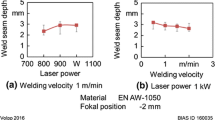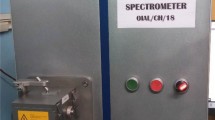Abstract
A numerical study of the laser welding process is presented. The numerical model is based on a combination of the enthalpy method and the finite difference techniques applied to the heat equation that can bypass the manual enforcement of the jump condition at the phase-separating surfaces. Minimal application of the “life and death of elements techniques” is required in order for the dynamics of the keyhole to be captured. This analysis results in the construction of the flowchart of a time-stepping algorithm, suitable for any software platform or computer language.
Similar content being viewed by others
References
Li L, Hong M, Schmidt M, Zhong M, Malshe A, Huis in’tVeld B, Kovalenko V (2011) Laser nano-manufacturing—state of the art and challenges. CIRP Ann Manu Technol 60:735–755. doi:10.1016/j.cirp.2011.05.005
Tönshoff HK, Egger R, Klocke F (1996) Environmental and safety aspects of electrophysical and electrochemical processes. CIRP Ann Manuf Technol 45:2:553–568
Dahotre NB, Harimkar SP (2008) Laser fabrication and machining of materials. Springer, New York
De KJ, Duflou JR, Kruth J-P (2007) Monitoring of high-power CO2 laser cutting by means of an acoustic microphone and photodiodes. Int J Adv Manuf Technol 35:115–126
Chryssolouris G (1991) Laser machining: theory and practice. Springer, New York
Ready JF, Farson DF (2001) LIA handbook of laser materials processing. Magnolia Publishing, Inc., Laser Institute of America
Tsoukantas G, Stournaras A, Chryssolouris G (2008) Experimental investigation of remote welding with CO2 and Nd: YAG laser-based systems. J Laser Appl 20:50–58
Klingbeil K (2006) What you need to know about remote laser welding: a look at how remote laser welding works and how it can be applied to your manufacturing process. Weld J 85:44–46
Zaeh MF, Munzert U, Oefele F (2007) Robot based remote laser-welding without scanner optics. In: Proceedings of the 4th International WLT-Conference on Lasers in Manufacturing, pp 1–8
Zaeh MF, Moesl J, Musiol J, Oefele F (2010) Material processing with remote technology-revolution or evolution? Phys Procedia 5:19–33. doi:10.1016/j.phpro.2010.08.119
Fysikopoulos A, Anagnostakis D, Salonitis K, Chryssolouris G (2012) An empirical study of the energy consumption in automotive assembly. Procedia CIRP 3:477–482. doi:10.1016/j.procir.2012.07.082
Anthony P (2004) The reality of remote laser welding. In Laser Solutions 19:9–11
Bemenek M (2006) Technology report: welding from a distance. In Laser Solutions 21:19–23
Sabo DA (2007) The evolution of scanners for remote welding applications: the rise of beam quality leads to proliferation of remote welding applications. http://www.thefabricator.com/article/lasercutting/the-evolution-of-scanners-for-remote-welding-applications. Accessed on 15 May 2014
Verhaeghe G (2012) Remote laser welding for automotive seat production. In Laser Solutions 27:6–11
Abderrazak K, Salem WB, Mhiri H, Lepalec G, Autric M (2008) Modelling of CO2 laser welding of magnesium alloys. Opt Laser Technol 40:581–588
Chen X, Wang HX (2001) A calculation model for the evaporation recoil pressure in laser material processing. J Phys D Appl Phys 34:2637–2642
Khan MMA, Romoli L, Dini G, Fiaschi M (2011) A simplified energy based model for laser welding of ferritic stainless steels in overlap configuration. CIRP Ann Manuf Technol 60:215–218
Phanikumar G, Chattopadhyay K (2000) Modeling of transport phenomena in laser welding of dissimilar metals. Int J Numer Methods Heat Fluid Flow 11:156–171
Kaplan A (1994) A model of deep penetration laser welding based on calculation of the keyhole profile. J Phys D Appl Phys 27:1805–1814
Ki H, Mohanty PS, Mazumder J (2002) Modeling of laser keyhole welding: part I. mathematical modeling, numerical methodology, role of recoil pressure, multiple reflections and free surface evolution. Metall Mater Trans A 33:1817–1830
Osher S, Sethian J (1988) Fronts propagating with curvature-dependent speed: algorithms based on Hamilton-Jacobi formulations. J Comput Phys 79:12–49
Burden RL, Faires JD (1993) Numerical analysis. PWS Publishing Co., Boston
Ki H, Mohanty PS, Mazumder J (2002) Modeling of laser keyhole welding: part II. simulation of keyhole evolution, velocity, temperature profile and experimental verification. Metal Mater Trans A 33:1831–1842
Rońda J, Siwek A (2011) Modelling of laser welding process in the phase of keyhole formation. Arch Civil Mech Eng 11:739–752
Al-Kazzaz H, Medraj M, Cao X, Jahazi M (2008) Nd: YAG laser welding of aerospace grade ZE41A magnesium alloy: modeling and experimental investigations. Mater Chem Phys 109:61–76
Shanmugam NS, Buvanashekaran G, Sankaranarayanasamy K (2013) Some studies on temperature distribution modeling of laser butt welding of AISI 304 stainless steel sheets. World Acad Sci Eng Technol 7:1088–1097
Spina R, Tricarico L, Basile G, Sibillano T (2007) Thermo-mechanical modeling of laser welding of AA5083 sheets. J Mater Process Technol 191:215–219
Lampa C, Kaplan AFH, Powell J, Magnusson C (1997) An analytical thermodynamic model of laser welding. J Phys D Appl Phys 30:1293–1299
Salonitis K, Stavropoulos P, Fysikopoulos A, Chryssolouris G (2013) CO2 laser butt-welding of steel sandwich sheet composites. Int J Adv Manuf Technol 69:245–256. doi:10.1007/s00170-013-5025-7
Sugioka K, Meunier M, Piqué A (2010) Laser precision microfabrication. Springer Ser Mater Sci 135:91–120
Solana P, Negro G (1997) A study of the effect of multiple reflections on the shape of the keyhole in the laser processing of materials. J Phys D Appl Phys 30:3216–3222
Akhter R, Steen W, Cruciani D (1988) Laser welding of zinc coated steel. In: Proceedings of the 5th International Conference on Lasers in Manufacturing, pp 105–120
Mei L, Chen G, Jin X, Zhang Y, Wu Q (2009) Research on laser welding of high strength galvanized automobile steel sheets. Optics & Lasers in Eng 47:1117–1124
Bley H, Weyand L, Luft A (2007) An alternative approach for the cost-efficient laser welding of zinc coated sheet metal. CIRP Ann Manuf Technol 56:17–20. doi:10.1016/j.cirp.2007.05.006
Chen G, Mei L, Zhang M, Zhang Y, Wang Z (2013) Research on key influence factors of laser overlap welding of automobile body galvanized steel. Optics Laser Technol 45:726–733
Svelto O (1998) Principles of lasers. Springer, New York
Douglas J, Gallie TM (1955) On the numerical integration of a parabolic differential equation subject to a moving boundary condition. Duke Math J 22(4):557–571
Crank J (1987) Free and moving boundary problems. Oxford University Press, pp 424
Swaminathan CR, Voller VR (1993) On the enthalpy method. Int J Numer Methods Heat Fluid Flow 3:233–244
Patankar SV (1980) Numerical heat transfer and fluid flow. Hemisphere Publishing Co., Washington, New York, London, p 197
Voller VR, Cross M, Markatos NC (1987) An enthalpy method for convection/diffusion phase change. Int J Numer Methods Eng 24(1):271–284
Morgan K (1981) A numerical analysis of freezing and melting with convection. Comput Methods Appl Mech Eng 28(3):275–284
Morgan K, Taylor C, Brebbia CA (1980) Computer methods in fluids. Pentech Press, London, pp 257–284
Voller VR, Cross M (1981) Accurate solutions of moving boundary problems using the enthalpy method. Int J Heat Mass Transf 24(3):545–556
Pastras G, Fysikopoulos A, Stavropoulos P, Chryssolouris G (2014) An approach to modeling evaporation pulsed laser drilling and its energy efficiency. Int J Adv Manuf Technol 72(9–12):1227–1241. doi:10.1007/s00170-014-5668-z
Author information
Authors and Affiliations
Corresponding author
Rights and permissions
About this article
Cite this article
Pastras, G., Fysikopoulos, A., Giannoulis, C. et al. A numerical approach to modeling keyhole laser welding. Int J Adv Manuf Technol 78, 723–736 (2015). https://doi.org/10.1007/s00170-014-6674-x
Received:
Accepted:
Published:
Issue Date:
DOI: https://doi.org/10.1007/s00170-014-6674-x




